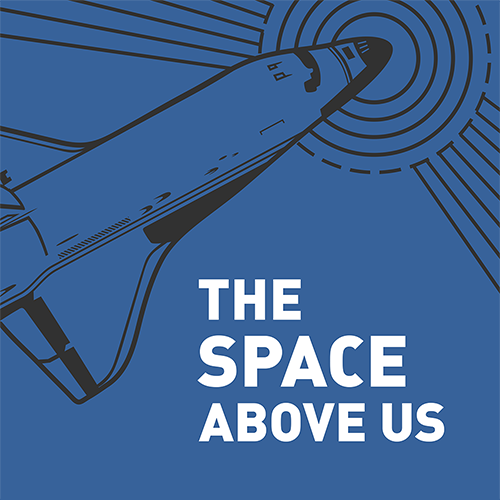Episode 152: STS-76 - Mirwalking (MEEP, Lucid to Mir)
Table of Contents
On STS-76 the space shuttle finally shuttles someone to space, delivering Shannon Lucid to Mir. We’ll also goof off in the SPACEHAB tunnel, head outside, and have fun saying the word “MEEP”.
Episode Audio #
Photos #
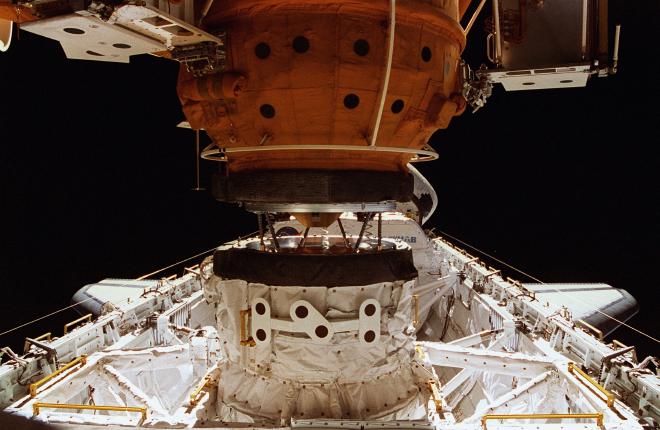
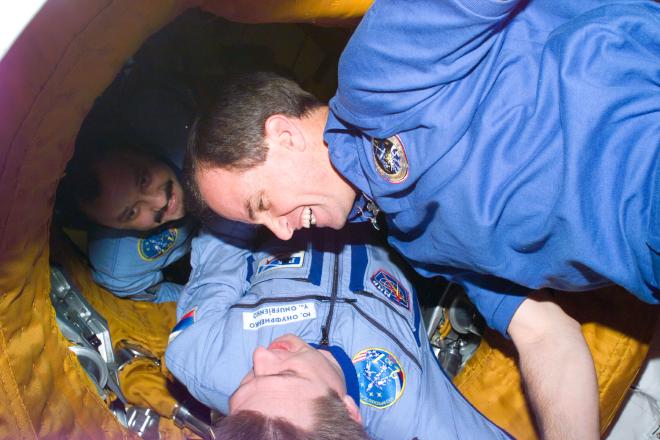
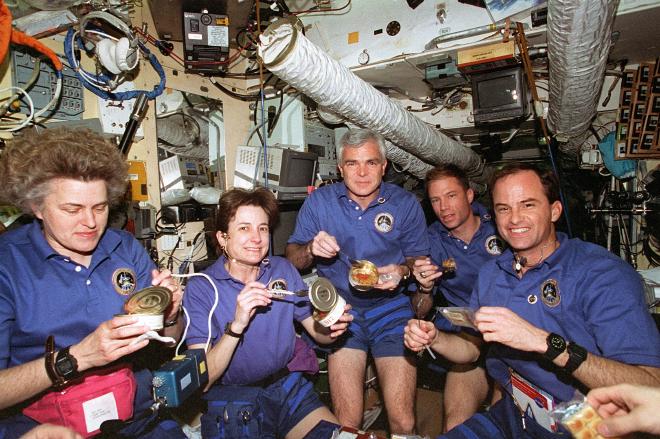
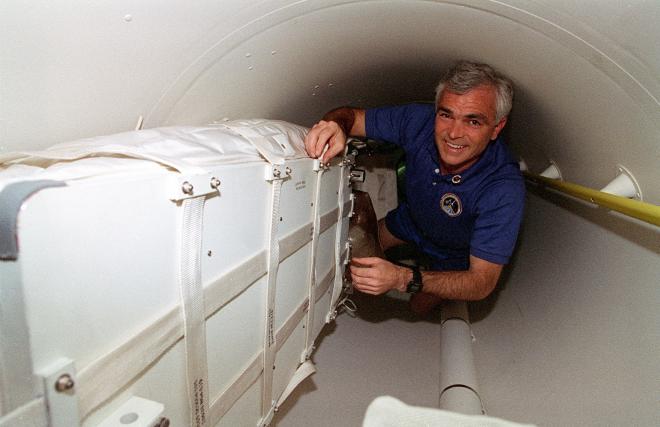
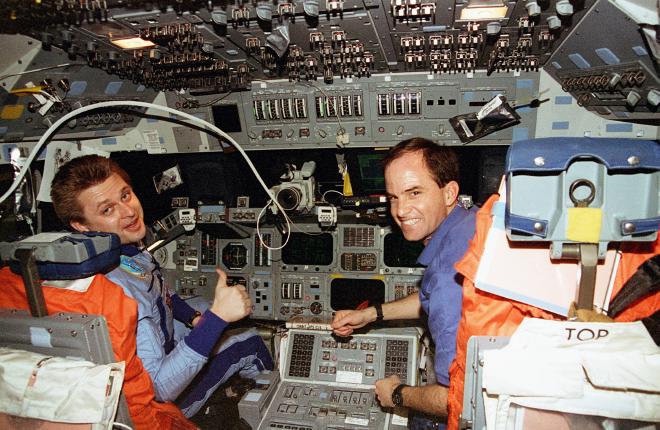
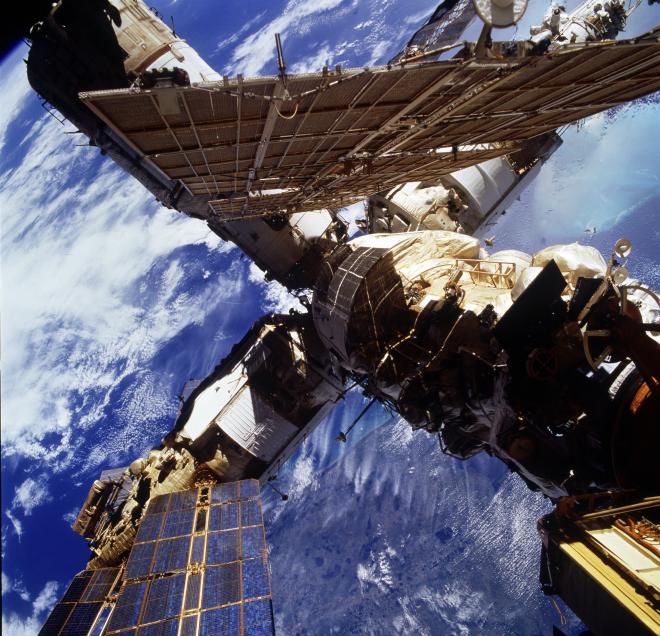
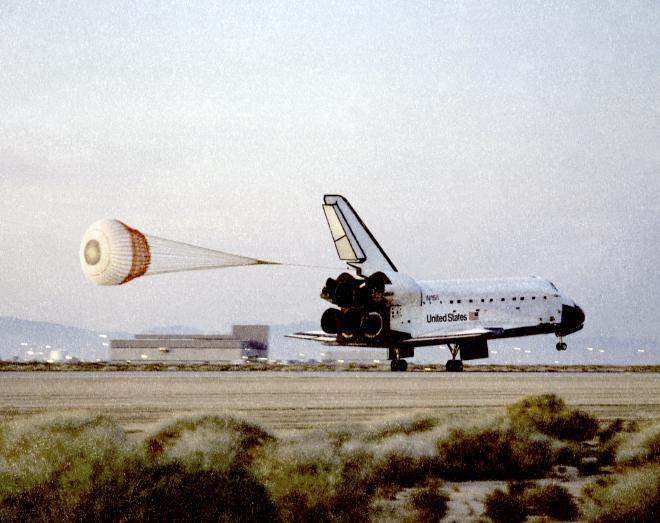
Post-Flight Presentation #
Transcript #
NOTE: This transcript was made by me just copying and pasting the script that I read to make the podcast. I often tweak the phrasing on the fly and then forget to update the script, so this is not guaranteed to align perfectly with the episode audio, but it should be pretty close. Also, since these are really only intended to be read by myself, I might use some funky punctuation to help remind myself how I want a sentence to flow, so don’t look to these as a grammar reference. If you notice any egregious transcription errors or notes to myself that I neglected to remove, feel free to let me know and I’ll fix it.
Hello, and welcome to The Space Above Us. Episode 152, Space Shuttle flight 76, STS-76: Mirwalking
Last time, we decided that the Tethered Satellite System deserved a second chance after its somewhat less than ideal first flight. Things went.. well, better than last time, but I think it’s safe to say that it too was less than ideal. We also learned a little more about relative motion, gravity gradients, and where UFO conspiracy theorists get their material. I’m betting that today’s mission is less popular with UFO crazies, but really it’s up their alley. That’s because today we’ll be delivering an advanced life form from its home planet to a new home in space. That advanced life form’s name? None other than Shannon Lucid!
Before Norm Thagard ever even launched on his groundbreaking voyage to the Russian space station Mir, others were already lining up to follow in his footsteps. We’ll meet the full group of Shuttle-Mir long haulers in due time, and next time we’ll be getting into all the details of Lucid’s training and mission, but first, we’ve got to get her there.
To accomplish this, Space Shuttle Atlantis will earn a special place in spaceflight history by becoming the first space shuttle.. to shuttle someone to space. We’re actually making good on the original vision of the shuttle and using it as a logistics vehicle to deliver supplies and personnel to an orbiting space station! OK, this is probably a pretty arbitrary distinction since we’ve already delivered cargo to Mir before and gave Norm and his Russian buddies a ride home, but you know me. I love a good arbitrary distinction. I promise you, though, that by the end of this episode, we’ll see a real deal spaceflight milestone. But first, let’s meet the crew.
Commanding this team entirely composed of spaceflight veterans is Kevin “Chili” Chilton, who is moving over to the seat on the left for the first time. We first saw him piloting Endeavour on its first mission, and most recently on STS-59, bouncing radar off the Earth’s surface. Today marks his third and final flight. Fun fact, after his time as an astronaut was done, Chilton would continue his Air Force career, eventually attaining the lofty rank of four-star general.
Joining Chilton up front was today’s Pilot, Rick Searfoss. When we last saw Searfoss he was piloting STS-58, a life sciences flight on Space Shuttle Columbia. Lucid was also on that flight, so today marks a little STS-58 reunion. This is Searfoss’ second of three flights.
Moving back in the flight deck we find Mission Specialist 1 Ron Sega, who flew on the very first Shuttle-Mir flight, STS-60. That flight didn’t dock with Mir, but it did get the program rolling by including Cosmonaut Sergei Krikalev. Unfortunately, the Wake Shield Facility, which Sega was instrumental in bringing to fruition, was unable to be deployed due to technical problems, but at least it didn’t go all TSS on us. This is Sega’s second and final flight.
Mission Specialist 2 and today’s flight engineer was Rich Clifford. Clifford’s inclusion marks another reunion of sorts since his previous flight was STS-59, the SIR-C radar flight piloted by one Kevin Chilton. Just like his commander, this is Clifford’s third and final flight.
Moving along to Mission Specialist 3 we find a third alum of STS-59: Linda Godwin. Since we already talked about her previous mission, how about her first, on STS-37? On that flight she helped to deploy the Compton Gamma Ray Observatory but had to just watch through the window as two of her crewmates headed outside on a couple of EVAs. But on today’s mission she’ll finally get to head outside for herself. This is her third of four flights.
And finally, our guest of honor, Shannon Lucid. Of course, we know Lucid from the class of 1978, being one of the first American women to earn the golden astronaut wings. She’s flown on a variety of missions, deploying commercial payloads, TDRS communication satellites, life science missions, and she even helped send our old buddy Galileo on its way to Jupiter. With today’s flight she’ll embark on yet another type of mission and become the first to use the shuttle as a taxi service to orbit. She won’t be the last. This is Lucid’s fifth and final mission.
Unfortunately for the crew of STS-76 and all the bleary-eyed folks lining the coast of Florida hoping to catch a glimpse of Atlantis’ rise to orbit, celestial mechanics don’t care one whit about the sleep schedules of humans. So when flight dynamicists crunched the numbers and determined the liftoff time required to deliver the shuttle and its crew to Mir, the answer that popped out was “ohhh, around 3 in the morning”. Oh well, these things happen. But unfortunately for the crew and sleepy space nerds, the Florida night was a little too windy to ensure a safe Return to Launch Site abort, if any RTLS abort can be called safe. With the narrow launch window dictated by the passage of the Kennedy Space Center through the orbital plane of Mir, there was no choice but to stand down and try again the next day. But fortunately for everyone involved.. this decision was made at the L-8 hour mark at a much more reasonable hour to be conscious.
The next day, the crew, mission controllers, and hardcore space nerds boiled up some Mountain Dew and got ready to try again. This time their efforts were rewarded by a countdown that was completely uneventful until 3:13 am on March 22nd, 1996, when the main engines roared to life, the solid rocket boosters ignited, and Space Shuttle Atlantis lit up the night sky. The ride uphill was largely uneventful other than a small leak of hydraulic fluid kept the pilot crew and mission controllers busy. Hydraulics are only needed during two parts of the mission, but those are some pretty important parts. The Auxiliary Power Units power the hydraulics that allow the pilot crew and flight computer to move the onboard control surfaces. No hydraulics, no control surfaces, no control, ..no landing. But after some quick troubleshooting the ground determined that the mission could continue as planned, though they’d be using the APU with the leak as little as possible. And just to be on the safe side, Russian Mission Control requested that the aft compartment vent doors be closed just in case any fluid had leaked in there and was just floating around. After all, nothing’s worse than hydraulic fluid on your solar array.
As usual, it’s going to take a few days to perform the complex dance that is orbital rendezvous, so let’s settle in and see what the crew’s up to. Linda Godwin and Rich Clifford dove right into the important task of checking out their Extravehicular Mobility Units, aka EMUs, aka spacesuits. It always sort of struck me as odd that the crews spent so much effort double checking that all was well with the suits right after launch since presumably this had also been done by the EVA specialists on the ground and technicians who packed it.. but hey it’s not like we haven’t seen issues before, and the stakes are pretty high. So you know what, have at it, Linda and Rich.
There was also plenty to prepare in the payload bay, where once again the SPACEHAB payload is riding in space. As Ben Evans discusses in his book “The Twenty-First Century in Space”, the commercial competitor to Spacelab hadn’t quite caught on like its investors were hoping. The original thought was that bids would be pouring in from industry and academia. There hadn’t been no interest, but there also hadn’t been nearly as much as had been expected. But no matter, the 9th Rule of Acquisition states that “Opportunity plus instinct equals profit” and SPACEHAB saw an opportunity in providing logistics for NASA. It turns out that if you want to bring thousands of pounds of stuff up to a space station, you need somewhere to keep it, and the middeck on the orbiter is pretty cramped. By loading a SPACEHAB module into the back of the payload bay and connecting it to the middeck with a long tunnel, the crew essentially gained a whole new room to stuff cargo into.
That’s not to say that there was no science getting done back there, though. The European Space Agency’s “Biorack” experiment was flying again, enabling some life science experiments to be performed on this largely logistics-focused flight. Specifically, Biorack would be carrying eleven experiments dedicated to studying the effects of weightlessness and high energy cosmic radiation particles on plants, tissues, cells, bacteria, and insects.
Catching a ride alongside the various plants and bugs inside Biorack was a refrigerator and freezer for returning samples back to Earth. All the blood, urine, and saliva samples collected by the Mir crews wouldn’t be much use in metabolic experiments if they weren’t kept cold and stable until they could get into a lab. Somewhat surprisingly, at least to me, no ice cream was included for the ride uphill on this flight. Maybe someone on STS-74 didn’t eat all their ice cream like they were supposed to.
After two days of phasing burns, plane changes, and re-targeting maneuvers, it was time to perform the Transition Initiation burn, kicking off the final swoop up to Mir. Just like last time, Atlantis was guided onto the R-bar, the invisible line between Mir and the center of the Earth, and began to slowly move up it, closer to the station. Today’s approach came with an extra twist, literally! In order to improve Mir’s communications with the ground, when Atlantis was about 250 meters below the station, Commander Chilton executed a 180 degree yaw, such that now the shuttle was flying engines-first.
In an interview with the Smithsonian, Mission Specialist Rich Clifford gave a quote that reminds us why it was so important to get the Mir Docking Adapter, with its extra clearance, delivered on STS-74. He said: Coming up to dock with Mir, approaching that tremendously large piece of machinery, it goes from being a very bright light to looking like a spider. Then all of a sudden, the station’s huge solar power array looks like it’s 10 inches from your window. And you’re thinking. “it’s a good thing we’re not slightly off axis.”
Well, with those solar arrays looming in the windows, Atlantis gently nudged into Mir’s docking adapter in a motion so smooth that Clifford said he couldn’t even feel it. Atlantis was back.
After the usual wait for the air pressure on either side of the hatch to equalize, the crews of both spacecraft gathered around the hatch between Atlantis and Mir. Video shot from onboard the shuttle shows Commander Chilton lowering the docking hatch and poking his head inside, only to be grabbed in a giant bear hug from the commander of Mir, Yuri Onufrienko. In Shannon Lucid’s book “Tumbleweed” she joked that both men kept trying to pull each other into the others’ spacecraft. The entire crew were soon welcomed into the Kristall module for hugs and excitement before moving on to the usual flags and formal ceremony. Among the gifts exchanged this time were a number of space themed books for the children of the cosmonauts, as well as copies of Jim Lovell’s book Lost Moon, which told the story of a far less lucky spaceflight 25 years earlier.
One of the first orders of business was to transfer some of the critical supplies brought to support Shannon Lucid’s mission. Chief among these was a custom-fitted liner for the right-hand seat of the Soyuz spacecraft. The plan was to retrieve Lucid on the shuttle a few months from now, but in the event of an emergency she might have to evacuate on the Soyuz. Since the reliable little spacecraft isn’t exactly known for its smooth landings, it was important that the seat liner be installed immediately. Once Lucid proved that the seat and her entry spacesuit were good to go, the transition was complete. 53 hours and 17 minutes into the mission, Lucid officially joined the Mir crew and began settling in to her new orbital home.
On flight day six, it was time for that real spaceflight milestone I mentioned earlier. For the first time in 22 years, Americans would be performing a spacewalk outside a space station. It would also mark the first time Americans would be performing a spacewalk outside a non-American spacecraft. In this case the Americans in question were Linda Godwin as EV1 and Rich Clifford as EV2, with Ron Sega assisting from inside. The goal today was to evaluate some new tools, set up some experiments that would help plan for the ISS, and snag a TV camera. Let’s head outside.
Thanks to the Smithsonian, we have another good quote from Rich Clifford, talking about the moments before heading outside. I’ll try to do my best with the sound effects, but he said: “Now it’s just Linda and I in there, two large suits in a small volume, one upside down and the other right side up. She’s down there opening the valve that lets out the air. There’s a loud pop like when you burst a balloon, and the air starts rushing out. It’s like a huge vacuum cleaner. The noise is shwoo shwoo, and both Linda and I are watching the gauges. Her hand is on the valve in case one of our suits doesn’t maintain pressure. She’d have to close it quickly, because you’ve got about 10 seconds to stabilize, otherwise you lose consciousness.”
While Godwin and Clifford make their way out into the payload bay and start gathering their tools, let’s find out what they’re doing here.
As we’ve discussed, planning was well underway for the upcoming International Space Station and naturally, this came with a lot of questions. One question was what the debris environment and radio spectrum was like in the orbit planned to be used by the ISS. The planned orbit had a relatively high inclination of 51 degrees, which was dictated by the latitude of the Russian launch site. Remember, your inclination is how tilted your orbit is with respect to the Earth’s equator. And if your launch site is 10 degrees North or South of the equator and you fly due East, you’re going to end up in a 10 degree inclination orbit. Flying into inclinations that are lower than where you start is tough and requires large amounts of energy, and since Russia would be a key contributor to the ISS, the station’s orbit would be dictated by their launch site, which was far north of the Kennedy Space Center.
Well, it just so happened that there was an easy to way figure out what this orbit was like since there was already a space station in a very similar orbit: Mir. For the radio spectrum the solution was simple enough. The crew carried with them a special antenna that was placed in one of the flight deck windows. It analyzed the radio spectrum from as low as 400 megahertz all the way up to 18 gigahertz, allowing engineers on the ground to get an idea of what they would be dealing with. For the debris question, we’ll have to get a little more hands on, which explains why Godwin and Clifford are heading outside.
The primary goal of this EVA was to head up to the Docking Module and deploy the Mir Environmental Effects Payload, which went by the delightful acronym “MEEP”. So first things first, Godwin and Clifford grabbed their tools and climbed up to the Docking Module so they could install some brackets that would hold MEEP in place. Their bright white spacesuits especially stood out against the burnt orange exterior of the Docking Module. Once the brackets were in place, the big boxy MEEP experiments could be installed and opened up. Imagine a metallic pizza box covered in little squares, and when you open the lid it continues to flip back until it does a full 360 and is now sticking to the bottom of the box. That’s basically what they looked like. But the simple appearance of these two pizza-box-like devices masked the fact that there were actually four separate experiments.
The Polished Plate Micrometeoroid and Debris experiment was basically just a flat surface with known characteristics that little bits of stuff could splatter into. By later counting how many splatters there are and how big they were, scientists could learn about how often they could expect to get hit and how hard the hit would be.
The Orbital Debris Collector experiment basically did what it said and used a special material to actually capture pieces of debris intact. That way in addition to knowing how big they are and how prevalent they are, scientists could actually learn what these pieces of debris were made out of.
And lastly, the Passive Optical Sample Assembly 1 and 2 experiments were sort of a mini LDEF. They had a bunch of samples of materials that were being considered for use in space station construction so NASA could see how they held up in the real environment.
MEEP would stay in place until another crew could pick it up on STS-86 so its results could be analyzed. And speaking of picking up stuff left by previous crews, while they were up on the Docking Module, Godwin and Clifford cut off a TV camera that was used during the STS-74 docking. I’m not really sure why but I’m guessing they were hoping to study how the camera had held up, just like on Apollo 12.
In addition to the practical task of setting up MEEP and grabbing the TV camera, this EVA served as a sort of test run for more extensive space station EVAs to come. We’ve seen a number of tests dedicated to seeing how spacewalkers can handle the colder temperatures and dimmer lights encountered when leaving the shuttle payload bay. Well now NASA had some practical experience with it. The crew also tried out some new lengthier tether lines and some bigger hooks that were compatible with the Russian equipment.
It’s also worth noting that while we’ve seen SAFER fly before, this was the first time it really counted. SAFER, again, was the little MMU style jetpack that stuck to the bottom of the spacesuit backpack. On past spacewalks, if a crew member drifted off into space it would be an emergency, but the shuttle could always go chase them down. But when the shuttle is docked, they can’t just go zooming after a stranded crew member at the drop of a hat. With SAFER, the crew member could just putt-putt their way back to the station. Thankfully, the little jetpack remained unused for this flight.
After 6 hours and 2 minutes outside, Godwin and Clifford sealed up the airlock hatch and the first Shuttle-Mir EVA was complete. It’s a shame that we couldn’t take a photo of these Americans crawling around outside a former Soviet space station and send it back to the people who designed it decades ago. Imagine what they would have thought.
The EVA was a big highlight of the docked portion of the flight, but most of the crew’s time involved a lot of transferring equipment. The shuttle crew transferred nearly 700 kilograms of water over the Mir, along with some extra oxygen and nitrogen in the form of a slight cabin over-pressure. They also delivered some Russian equipment including an attitude control device called a gyrodine, returning a used gyrodine to Earth for analysis alongside some rendezvous equipment for refurbishment. In total, over 2100 kilograms of supplies were transferred to the station
The many trips up and down the SPACEHAB tunnel in order to ferry cargo also gets us one more interesting quote from Rich Clifford, who said: “On my third flight, STS-76, we had this long, 35-foot tunnel leading from the shuttle mid-deck to the SPACEHAB laboratory module in the back. We took a large rubber band - called a Dyna-Band - that we used for exercise and stretched it across the airlock hatch on the mid-deck. Then we’d shoot ourselves down the tunnel. One of the crew members would shoot you down, and we had a competition to see who could do it without touching the tunnel walls. Nobody ever made it.”
After around 120 hours of docked time, it was time to head home. The crews exchanged goodbyes, including Lucid and her former shuttle crew.
Once the hatches were sealed and the space between them was vented, the docking mechanism disengaged and Atlantis began to back away. A few seconds later, Commander Chilton blipped the thrusters in the low-z configuration, gently moving the orbiter away while keeping the thrusters firing away from the station. Over the next hour, Chilton expertly maneuvered the orbiter around Mir, allowing for inspection and photography. He called it quote “one of the most professionally rewarding things I’ve ever done” but was also clearly moved by the beauty of this human-made structure serenely flying above the earth, calling it “flabbergasting.” After a few more blips of the RCS thrusters, that flabbergasting sight faded off into the distance, and Atlantis was on its own again.
The bulk of this flight was dedicated to supporting the Shuttle-Mir program, but there was still room for other stuff. One interesting payload called KidSat took the form of a remotely operated camera mounted in one of the flight deck overhead windows when not docked with Mir. Kids on the ground would be able to operate the camera, taking photos of the Earth which were then downlinked for them to view. It even had a website, which was pretty impressive back in 1996. Though I gotta say, I looked it up on the Internet Archive’s Wayback Machine.. and it looks exactly like you would expect a website for kids from 1996 to look like. We’ll see KidSat again on at least one more flight down the line.
While still docked to Mir, the decision was made to try to land a day early due to concerns about the predicted weather. But even with the attempted early return, Florida refused to cooperate, as it so often does, and Atlantis got an extra day on orbit. The next day they suited up and tried again, but after a third wave-off at Kennedy, the pilot crew set their sights on Edwards Air Force Base. After an uneventful reentry and landing, Atlantis touched down on the runway in the pre-dawn twilight, only ten minutes before sunrise. Despite the abundance of light, Chilton laughingly said that he made sure to log it as a night landing since technically the sun still hadn’t risen. At wheels stop, the mission had lasted 9 days, 5 hours, 15 minutes, and 53 seconds. The Shuttle-Mir program was really starting to hit its stride, and the budding partnership between the United States and Russia in space was just getting started.
Next time.. STS-76 was unusual in that it was the first American spaceflight to land with fewer people than it launched with. So next time, we’ll follow that missing crew member all the way to landing and stay on orbit with Shannon Lucid, once again slipping into the day to day rhythm of an extended mission in space. I hope the Russians remembered to pack the brandy.
Ad Astra, catch you on the next pass.
